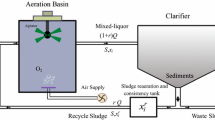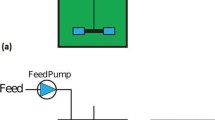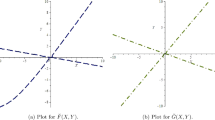Abstract
This paper deals with output feedback control of phytoplanktonic algae growth models in the chemostat. The considered class of model is of variable yield type, meaning that the ratio between the environmental nutrient absorption rate and the cells’ growth rate varies, which is different from classical bioprocesses assumptions. On the basis of weak qualitative hypotheses on the analytical expressions of the involved biological phenomena (which guarantee robustness of the procedure toward modeling uncertainties) we propose a nonlinear controller and prove its ability to globally stabilize such processes. Finally, we illustrate our approach with numerical simulations and show its benefits for biological laboratory experiments, especially for ensuring persistence of the culture facing classical experimental problems.





Similar content being viewed by others
References
Bernard O (1995) Etude expérimentale et théorique de la croissance de Dunaliella tertiolecta soumise à une limitation variable de nitrate utilisation de la dynamique transitoire pour la conception et la validation de modèles. Université Paris VI
Bernard O, Gouzé JL (1995) Transient behavior of biological loop models with application to the Droop model. Math Biosci 127:19–43
Chicone C (1999) Ordinary differential equations with applications texts in applied mathematics. Springer, Berlin Heidelberg New York
Droop MR (1968)Vitamin B12 and marine ecology. IV. The kinetics of uptake growth and inhibition in Monochrysis Lutheri. J Mar Biol Assoc UK 48:689–733
Henson MA, Seborg DE (1997) Nonlinear process control. Prenctice Hall, Englewood Cliffs
Khalil HK (1992) Nonlinear systems. Macmillan, New York
Lange K, Oyarzun FJ (1992) The attractiveness of the Droop equations. Math Biosci 111:61–278
Luenberger DG (1979) Introduction to dynamic systems. Theory models and applications. Wiley, New York
Mailleret L (2003) Positive control for a class of nonlinear positive systems. In: Benvenutti L, De Santis A, Farina L (eds) Positive systems Lecture Notes in Control and Informations Sciences, vol 294. Springer, Berlin Heidelberg New York, pp 175–182
Mailleret L (2004) Stabilisation globale de systèmes dynamiques positifs mal connus. Applications en biologie. Université de Nice Sophia, Antipolis
Mailleret L, Bernard O, Steyer JP (2003) Robust regulation of anaerobic digestion. Processes Water Sci Technol 48(6):87–94
Mailleret L, Bernard O, Steyer JP (2004) Nonlinear adaptive control for bioreactors with unknown kinetics. Automatica 40(8):1379–1385
Markus L (1956) Asymptotically autonomous differential systems. Annals of mathematics studies 36. Princeton University Press, New Jersey, pp 17–29
Monod J La technique de culture continue; théorie et applications. Annales de l’Institut Pasteur 79:390–401
Nijmeijer H, van der Schaft AJ (1991) Nonlinear dynamical control systems. Springer, Berlin Heidelberg New York
Oyarzun FJ, Lange K (1994) The attractiveness of the Droop equations. 2. Generic uptake and growth functions. Math Biosci 121:127–139
Smith HL (1995) Monotone dynamical systems an introduction to the theory of competitive and cooperative systems. Mathematical surveys and monographs. American Mathematical Society
Smith HL, Waltman P (1995) The theory of the chemostat: dynamics of microbial competition. Cambridge University Press, Cambridge
Thieme HR (1992) Convergence results and a Poincaré-Bendixson trichotomy for asymptotically autonomous differential equations. J Math Biol 30:755–763
Acknowledgements
We would like to thank the “Action Inter EPST Bioinformatique” for its financial support (SEMPO II Project).
Author information
Authors and Affiliations
Corresponding author
Appendices
A Nomenclature
Parameter values and units are according to [1] (for all the simulations):
B Barbalat’s lemma
Lemma 2 (Barbalat, [6])
Let \(\phi : {\mathbb R}\rightarrow {\mathbb R}\) be a uniformly continuous function on [0, ∞). Suppose that \(\lim_{t\rightarrow +\infty}\int_0^t \phi(t)\hbox{d}t\) exists and is finite. Then:
C Corollary of the Perron-Frobenius theorem
Definition 1, (Metzler matrix, [8])
A is a Metzler matrix iff all its off-diagonal elements are non-negative.
Corollary 1, (Perron-Frobenius, [17])
Let A be an irreducible Metzler matrix. Then, λ M , the eigenvalue of A of largest real part is real, and the elements of its associated eigenvector v M are positive. Moreover, any eigenvector of A with non-negative elements belongs to span {v M }.
Remark 4
Actually, Smith proves more in his corollary (see [17]), but the remaining results are of no use for our purpose.
D Asymptotically autonomous systems
Definition 2 [13, 19]
Consider the systems:
with f(x,t) and g(x) continuous in x and t and locally Lipschitz in x on an open set \(\theta\subset{\mathbb R}^n.\) System Eq. 13 is asymptotically autonomous with limit system Eq. 14 if for all compact \(K\subset\theta:\)
Theorem 1 [13, 19]
Consider the asymptotically autonomous system Eq. 13 with limit system Eq. 14 . Let e be a locally asymptotically stable equilibrium of Eq. 14 and ω the ω -limit set of a bounded solution x(t,x 0) of Eq. 13 . If ω contains a point y 0 such that the forward trajectory y (t,y 0) of Eq. 14 converges to e, then:
Remark 5
Observe that in our case, each forward trajectory of the limit system Eq. 11 initiated in \(\mathcal{E}.\)converges toward \(s^\star,\) and each trajectory of the asymptotically autonomous system Eq. 12 converges to \(\mathcal{E}.\) Then, each trajectory of the asymptotically autonomous system Eq. 12 converges to \(s^\star.\)
Rights and permissions
About this article
Cite this article
Mailleret, L., Gouzé, J.L. & Bernard, O. Nonlinear control for algae growth models in the chemostat. Bioprocess Biosyst Eng 27, 319–327 (2005). https://doi.org/10.1007/s00449-005-0410-8
Received:
Accepted:
Published:
Issue Date:
DOI: https://doi.org/10.1007/s00449-005-0410-8




